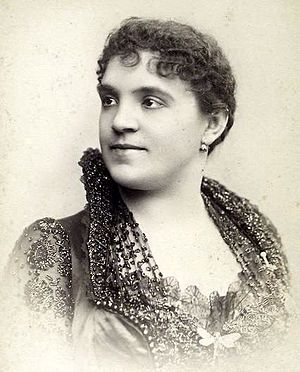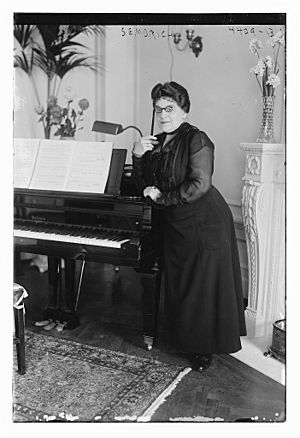Marcella Sembrich facts for kids
Prakseda Marcelina Kochańska (born February 15, 1858 – died January 11, 1935) was a famous Polish opera singer. She was known by her stage name, Marcella Sembrich. Marcella had an amazing singing voice, often described as "flute-like," "sweet," and "pure." She could sing a very wide range of notes.
Marcella Sembrich had a big international career. She performed mainly at the New York Metropolitan Opera in the United States and the Royal Opera House in London, England.
Contents
Early Life and Musical Beginnings
Marcella Sembrich was born in a place called Wisniewczyk. This area was part of the Austro-Hungarian Empire, but it is now in Ukraine. From a young age, Marcella showed great musical talent.
She first learned to play the violin and piano from her father. To help her family and pay for her lessons, she often played music at parties for rich families. She also played in the town center, and people really liked her music.
When she was ten years old, an older man named Dziadek Lanowitch noticed her talent. He helped her go to the Lviv Conservatory in Lwow, Poland, to continue her studies.
Education and Voice Training
At the Lviv Conservatory, Marcella studied piano with Wilhelm Stengel, who later became her husband. She also studied violin. When she was sixteen, Stengel took her to meet the famous composer Franz Liszt in Germany.
Liszt was very impressed with her voice. He told her, "Sing, sing for the world, for you have the voice of an angel." This encouraged Marcella to focus on singing. She then went to Vienna and Milan to study voice.
In 1875, she started studying at the University of Music and Performing Arts Vienna. After a year, she decided to stop playing the violin and piano. She wanted to focus completely on her singing lessons. In 1876, she traveled to Milan, Italy. There, she studied with Giovanni Battista Lamperti, one of the best voice teachers in Europe.
A Star is Born: Marcella's Career
Opera Debut and Early Success
After less than a year of voice lessons, Marcella Sembrich made her first opera performance. This happened in Athens, Greece, on June 3, 1877. She sang the role of Elvira in an opera called I puritani. She quickly learned many different opera roles in foreign languages. This showed how smart and well-trained she was. Marcella could speak English, Polish, German, French, and Italian.
That same year, she married her piano teacher, Wilhelm Stengel. When she first performed, she used the name "Marcella Bosio." She thought her real last name was too hard for people to say. Later, she decided to use her mother's maiden name, Sembrich, instead.
Rising to Fame in Europe
After a break due to pregnancy, Marcella was hired by the Dresden Royal Opera House in Germany in 1878. She performed as Lucia and was an instant success! People started calling her the "Polish Adelina Patti," comparing her to another famous singer. She stayed in Dresden until 1880.
Then, she went to London, England, and made her debut at Covent Garden in June 1880. She was amazing as Lucia in Lucia di Lammermoor. She became a favorite in many roles, including Zerlina, Susanna, and Konstanze.
Conquering the Metropolitan Opera
In 1883, Sembrich came to the United States to sing with the new Metropolitan Opera company in New York City. Her first performance there was also as Lucia, on October 24, 1883. Marcella Sembrich sang more debut roles than any other singer in the Met's history!
She was the first to sing many famous roles at the Met, such as the Queen of the Night in The Magic Flute and Violetta in La traviata. She was also the first to record her voice on special cylinders backstage at the Met.
After a few years, Marcella moved to Berlin, Germany. For the next thirty years, she traveled all over the United States and Europe. She sang in major cities like London, Paris, and New York. She was very popular at the Italian Opera from 1890 to 1897.
Sembrich returned to the Met in 1898. In total, she sang over 450 performances there during her 11 seasons. She stayed connected with the company until 1909, when she had a special farewell concert celebrating her 25 years since her Met debut.
Later Life and Teaching
Marcella Sembrich continued to give concerts until 1917. She often ended her shows by playing the piano or violin herself. Many people believed her experience with the violin helped her become such a natural and skilled singer.
She also worked hard to promote Polish art and music. Her concerts almost always included a piece by a Polish composer. After retiring from performing, she started teaching voice at two famous music schools: the Curtis Institute in Philadelphia and the Juilliard School of Music in New York.
Many of her students became important singers and teachers themselves. This shows how much of an impact she had on the next generation of musicians.
During World War I, Marcella could not travel to her beloved Alps mountains for summer. Instead, she spent her summers in the Adirondack Mountains in New York. She lived at Lake Placid from 1915 to 1921, and then at Lake George from 1922 to 1934. Today, you can visit the Marcella Sembrich Opera Museum in Bolton Landing, New York. It has many items from her amazing career.
Death
Marcella Sembrich passed away on January 11, 1935. She died at her home in Manhattan, New York City.
Legacy and Impact
After her death, newspapers like The New York Times wrote about Marcella Sembrich's incredible career. Fans around the world were sad to lose such a great artist. The New York Times said that her death meant losing one of the last artists who connected them to the great traditions of the past.
Off stage, Marcella was also a dedicated teacher and helped many people.
- Every summer, Sembrich would host her students at her studio on Lake George. They would continue their music studies with her there. Today, this studio is the Marcella Sembrich Opera Museum.
- She made a big impression on both her teachers and students. Her former teacher, Giovanni Battista Lamperti, even dedicated his book about singing to her.
- Marcella was a proud Polish patriot and a kind humanitarian throughout her life. During World War I, she was the President of the American-Polish Relief Committee in New York. She worked hard to raise money, food, and clothes for her suffering country people.
- The Kosciuszko Foundation, which promotes Polish culture in New York City, holds an annual singing competition named after her: the "Marcella Sembrich Voice Competition."
- She also organized concerts to raise money for victims of the 1906 San Francisco earthquake.
- Two portraits of Sembrich were painted in 1899, but they are now lost. A portrait of her from 1936 hangs in the Metropolitan Opera House today. She also made some early recordings of her voice before World War I.
See also
 In Spanish: Marcella Sembrich para niños
In Spanish: Marcella Sembrich para niños
- List of Poles





